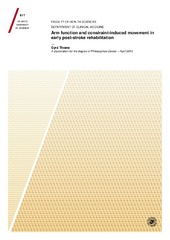Arm function and constraint-induced movement in early post-stroke rehabilitation
Permanent lenke
https://hdl.handle.net/10037/8208Åpne
(PDF)
Arm use in patients with subacute stroke monitored by accelerometry: association with motor impairment and influence on self-dependence. Thrane G, Emaus N, Askim T, Anke A. Also available in Journal of Rehabilitation Medicine. 2011 Mar;43(4) (PDF)
A meta-analysis of constraint-induced movement therapy after stroke. Thrane G., Friborg O., Anke A. Also available in Journal of Rehabilitation Medicine. 2014 Oct;46(9) (PDF)
Dato
2015-09-10Type
Doctoral thesisDoktorgradsavhandling
Forfatter
Thrane, GyrdSammendrag
Constraint-induced movement therapy (CIMT) is a treatment for mild-to-moderate upper extremity motor dysfunction in post-stroke patients. However, as the ideal time to initiate post-stroke treatment remains uncertain, more information is needed regarding the effects of CIMT and arm use in the early stages of stroke recovery. This thesis aimed to:
1) examine the correlations between arm motor impairment and real world arm use and its relationship with dependency in self-care activities in patients in the stroke unit. (Paper I)
2) assess the effects of modified CIMT applied within 28 days after stroke occurrence (Paper II)
3) review existing literature for the effects of CIMT on body function, activity, and participation in post-stroke patients (Paper III)
In Paper I, we found a high correlation between motor impairment and the patient’s actual use of the more affected arm. Further findings revealed that both the Fugl-Meyer motor assessment scores and arm use are related to dependency in self-care activities, but the finding might be confounded by lower extremity motor function. In Paper II, we found that CIMT initiated within 28 days after stroke occurrence was safe and feasible but did not improve long-term motor function. However, there was a significant effect on movement speed immediately after the treatment, and CIMT might promote a faster recovery compared to standard care. There were no differences between the groups with respect to reduced arm motor impairment or increased arm use. In the systematic review and meta-analysis conducted in Paper III, we found that CIMT can improve arm motor function and arm motor activities and may have a lasting effect on arm motor activity. The effects were especially stable in the sub-acute and chronic groups, and CIMT is therefore advocated for selected patients in these post-stroke stages.
Taken together, our study revealed that early CMIT has an immediate effect on timed measures of arm activity but does not improve long-term motor activity. The meta-analysis also showed uncertain effects of CIMT in the early post-stroke phase. This rehabilitative treatment should preferably be offered to patients in sub-acute and chronic stages after stroke. As learned nonuse might not be pronounced in the acute stage of stroke, the treatment should be aimed at preventing its development.
Beskrivelse
Paper II of this thesis is not available in Munin.
Efficacy of constraint-induced movement therapy in early stroke rehabilitation: A randomized controlled multisite trial. Thrane G, Askim A, Stock R, Indredavik B, Gjone R, Erichsen A, Anke A.
Available in Neurorehabilitation and Neural Repair, 2015, Jul;29(6)
Efficacy of constraint-induced movement therapy in early stroke rehabilitation: A randomized controlled multisite trial. Thrane G, Askim A, Stock R, Indredavik B, Gjone R, Erichsen A, Anke A.
Available in Neurorehabilitation and Neural Repair, 2015, Jul;29(6)
Forlag
UiT The Arctic University of NorwayUiT Norges arktiske universitet
Metadata
Vis full innførselSamlinger
Copyright 2015 The Author(s)
Følgende lisensfil er knyttet til denne innførselen:


 English
English norsk
norsk
